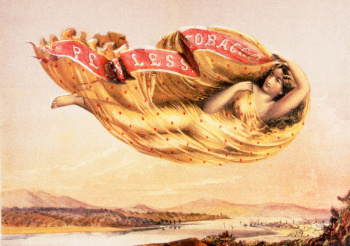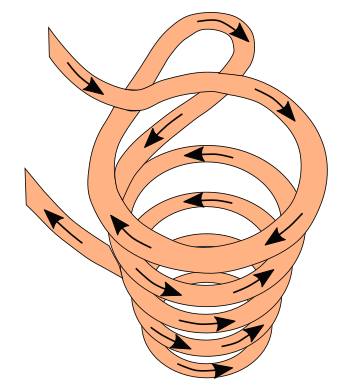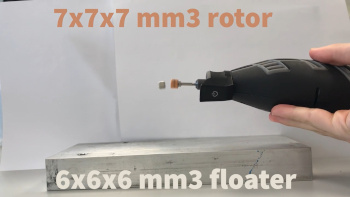Levitation
May 13, 2024
A common
stage magician's illusion is
levitation. As can be easily
imagined, levitation of small objects, such as
pens and
playing cards, is done using
thin threads. The threads are black, and they're rendered
invisible against the magician's black
clothing. More impressive is levitation of a
supine person, which is accomplished by a lifting
platform unseen by the
audience. The magician usually passes a
hoop around the person to prove levitation; but, a careful
spectator will see that the hoop is passed to avoid the
lever arm of the platform
mechanism. In our
Internet connected age,
videos of these illusions are easily found online.

Heavenly body - Levitating woman on the label of Suggett & Kimball's Peerless tobacco, 1864.
(Cropped Wikimedia Commons image from the United States Library of Congress, Prints and Photographs division, digital image cph.3g04305. Click for larger image.)
Materials scientists employ actual levitation when they need to
heat a
metal to a
temperature higher than what a
crucible can withstand. I practiced levitation
melting early in my
career as a member of a team doing
experiments on HfV
2, an
alloy of
hafnium with
vanadium.[1-2] This alloy is a
superconductor at 9.57
K, and it also absorbs
hydrogen. Our objective was to see how hydrogen would affect its superconductivity.[1-2] Hafnium has a very high
melting point, 2,233
°C, as does vanadium at 1500 °C. Hafnium is a very
reactive metal; so, containerless melting in a
vacuum was required to make the alloy.
Containerless melting was done by heating the metals in a
vacuum chamber and using
electrodynamic levitation in an
induction coil. As shown in the figure, this coil was formed from
copper tubing so that it could be
water cooled to prevent its melting from
radiant heat. The coil was attached to a
radio frequency generator commonly used for
induction heating. The
currents in the coil induce
eddy currents in metals contained within, and these currents heat the metals and produce a
magnetic field in the metals that opposes the magnetic field of the currents in the coil to levitate the metals. When the generator is turned off, the molten alloy blob falls into a
quenching bath.

A levitation coil, commonly made from water-cooled copper tubing.
The arrows show the direction of an instantaneous current.
The top coil turn is wound in an opposite direction to prevent the specimen from flying out of the coil. The conical shape concentrates the currents at the bottom to stabilize levitation, and the shape can hold the metal pieces before levitation.
A nice example of levitation heating can be seen in this YouTube video.
(Created using Inkscape.)
If you have an
induction cooktop in your
home, it's possible to crudely demonstrate this same electromagnetic levitation with a piece of
aluminum foil. Not having an induction cooktop in my home, I haven't done this myself, but
safety precautions must be observed in any
experiment. In this case, the possible
dangers are unknown, but there are some Internet videos demonstrating this effect. The same eddy current principle of the induction coil in the figure applies to this levitation.
As most have experienced, it's not possible to levitate a
permanent magnet above another unless there's a means to prevent the top magnet from flipping over. One interesting example of unconstrained magnetic levitation is the levitation of a
superconductor above a permanent magnet. The stable levitation in this case arises from the
Meissner effect, the exclusion of
magnetic fields from a superconductor. The permanent magnet induces eddy currents that produce a magnetic field that acts oppositely to that of the permanent magnet to cause the stable
repulsion.
Eddy currents caused by
oscillating magnetic fields do not appear to be responsible for the stability of some spectacular levitations by a
research team from the
Technical University of Denmark (DTU, Lyngby, Denmark) and the
University of Modena and Reggio Emilia (Modena, Italy).[3-5] This research is a further investigation of a novel form of levitation first found by
Turkish electronics engineer, Hamdi Ucar, in 2021.[5] Ucar attached one magnet with its
magnetic pole-to-pole axis perpendicular to the
rotation axis of a 10,000
rpm motor.[5] This magnet was able to lift a second magnet into stable levitation a few
centimeters below the rotating magnet.[5] Not only that, but the second magnet could be levitated when the rotating magnet was
angled to be
horizontal to the
Earth's gravitational field (see figure).[5]

Permanent magnet levitated by a rotating magnet in a Technical University of Denmark demonstration.
In this demonstration, a common household crafting tool, a Dremel rotary tool, is used. Both magnets are high strength NdFeB magnets that are also electrically electrically conductive.
(Screenshot from an APS video. Click for larger image.)
In their detailed experiments, the research team used a rotating 19 millimeter
diameter spherical NdFeB magnet to levitate
floater magnets, other spherical NdFeB magnets, of 5-30 millimeter diameter.[3-5] During levitation, the floater magnets had their
magnetization oriented close to the axis of rotation and toward the like pole of the rotor magnet, contrary to the expectation that the magnetization should be perpendicular to the
magnetization of the rotor magnet.[3-4] Levitation of smaller floater magnets was more difficult, requiring a higher rotational speed to achieve levitation at a greater separation.[3-4] In all cases, levitation ceased after a time, unless an
aluminium plate was placed below the floater magnet to
dampen its
oscillation by eddy currents.[3-4] In that case, perpetual levitation was achieved.[3-4]
It was determined that the induced eddy currents inside the magnets are extremely small; so, the eddy current mechanism can't be responsible for the levitation.[5] It's proposed that the stable levitation arises from
magnetostatic forces caused by a small
tilt in the relative rotational axes of the magnets.[5] This magnetostatic cause for the magnetic levitation does not require
gravity as a balancing force.[3-4]
Numerical simulations found that the rotating magnetic field causes a
torque on the floater magnet, and the floater magnet and rotating magnet experience both attractive and repulsive forces that balance in the levitation.[5]
References:
- P. Duffer, D. M. Gualtieri, and V. U. S. Rao, "Superconductivity of the Hydrides and Deuterides of HfV2," Magnetism And Magnetic Materials - 1976: Proceedings of the First Joint MMM‐Intermag Conference (Pittsburgh, Pennsylvania, June 15-18, 1976), AIP Conference Proceedings, vol. 34, no. 1 (September 1, 1976).
- P. Duffer, D.M. Gualtieri, and V.U.S. Rao, "Pronounced Isotope Effect in the Superconductivity of HfV2 Containing Hydrogen (Deuterium)," Phys. Rev. Lett., vol. 37, no. 21 (November 22, 1976), pp. 1410-1413.
- Joachim Marco Hermansen, Frederik Laust Durhuus, Cathrine Frandsen, Marco Beleggia, Christian R.H. Bahl, and Rasmus Bjørk, "Magnetic levitation by rotation," Phys. Rev. Applied, vol. 20, no. 4 (October 13 2023), Article no. 044036, DOI:https://doi.org/10.1103/PhysRevApplied.20.044036.
- Joachim Marco Hermansen, Frederik Laust Durhuus, Cathrine Frandsen, Marco Beleggia, Christian R. H. Bahl, and Rasmus Bjørk, "Magnetic levitation by rotation," arXiv, October 23, 2023, https://doi.org/10.48550/arXiv.2305.00812.
- Rachel Berkowitz, "How Rotation Drives Magnetic Levitation," Physics, vol. 16, no. 177, October 13, 2023.
Linked Keywords: Stage (theater); magic (illusion); magician; illusion; levitation; imagination; imagine; pen; playing card; invisible thread; thin thread; invisibility; invisible; clothing; supine; human; person; platform; audience; hoop; spectator; lever arm; mechanism (engineering); Internet; information age; connected age; Video clip; Suggett & Kimball's peerless tobacco; heaven; heavenly; human body; levitating; woman; packaging and labeling; label; tobacco; Wikimedia Commons; United States Library of Congress; digital image; materials science; materials scientist; heat; metal; temperature; crucible; melting; career; experiment; alloy; hafnium; vanadium; superconductivity; superconductor; kelvin; hydrogen; melting point; Celsius; °C; chemical reaction; reactive; vacuum chamber; vacuum; electrodynamic suspension; electrodynamic levitation; inductance; induction coil; copper tubing; water cooling; water cooled; thermal radiation; radiant heat; radio frequency; induction heating; electric current; eddy current; magnetic field; quenching; quenching bath; coil; sample (material); specimen; cone; conical; stabilize; YouTube video; Inkscape; induction cooking; induction cooktop; home; aluminum foil; safety precaution; hazard; danger; permanent magnet; Meissner effect; magnetic field; repulsion; oscillation; oscillating; research; Technical University of Denmark (DTU, Lyngby, Denmark); University of Modena and Reggio Emilia (Modena, Italy); Turkey; Turkish; electronic engineering; electronics engineer; magnetic pole; axial symmetry; axis; perpendicular; rotation around a fixed axis; rotation axis; revolutions per minute (rpm); electric motor; centimeter; angle; angled; horizontal plane; gravity of Earth; Earth's gravitational field; magnet levitated by a rotating magnet; household; craft; crafting; tool; Dremel; rotary tool; maximum energy product; high strength; neodymium magnet; NdFeB; electrical conductor; electrically conductive; screenshot; APS video; diameter; sphere; spherical; magnetization; aluminium; plane (geometry); plate; damping; dampen; oscillation; magnetostatics; magnetostatic; forces; axial tilt; tilt; gravitation; gravity; computer simulation; numerical simulation; torque.